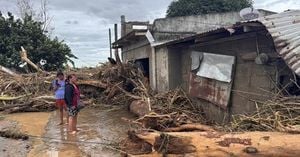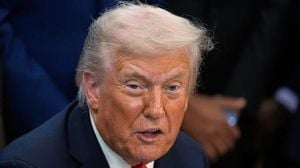In a remarkable display of creative energy and cultural pride, the BRICS+ Fashion Summit in Moscow has thrust Africa’s fashion industry into the global spotlight, signaling a dramatic shift in the balance of influence within the world of style. Held from August 28 to September 2, 2025, as part of Moscow Fashion Week, the event gathered over 600 participants—including 130 brands and delegates from more than 60 countries, with a particularly strong contingent from 15 African nations, stretching from Tunisia in the north to South Africa in the south. The summit, now in its third year, has rapidly become the largest international fashion forum of its kind, promoting decentralization and democratization in an industry long dominated by established Western capitals.
According to event organizers, the summit’s ethos was rooted in forging “collaborative pathways forward,” drawing together designers, policymakers, and industry leaders from the BRICS+ nations, Africa, Latin America, Southeast Asia, the Middle East, and Eastern Europe. The goal? To create a new model for fashion—one that centers diverse voices, fosters South-South and East-West collaboration, and actively builds the future of the industry rather than simply reflecting it.
Central to this year’s summit was Africa’s growing influence. The continent’s textile exports, currently representing 2-3% of the global market, are climbing steadily, with countries like South Africa, Ethiopia, and Kenya leading the charge thanks to their quality craftsmanship, innovative spirit, and commitment to sustainable practices. The African Development Bank projects that by 2025, consumer spending across the continent will surpass $2 trillion, with fashion and textiles comprising a substantial share—a testament to the sector’s dynamism and potential.
The summit’s agenda was packed with sessions that explored how African designers are reshaping global aesthetics by blending heritage with modernity. A landmark panel brought together industry luminaries such as Mahlet Teklemariam (Founder, Hub of Africa Fashion Week, Ethiopia), Susan Sabet (Secretary General, Egyptian Fashion & Design Council), Mahlet Afework (Founder, Mafi Mafi, Ethiopia), Nana Tamakloe (CEO, Accra Fashion Week, Ghana), Mmantlha Sankoloba (CEO, Botswana Exporters & Manufacturers Association), and Anis Montacer (President, Tunis Fashion Week). Their discussions delved into how cultural authenticity, bold color, and the innovative use of traditional materials are fast becoming Africa’s competitive edge in the global market.
“BRICS+ exemplifies how large-scale, multicultural fashion forums can drive meaningful exchange. Fashion isn’t just clothing—it’s cultural diplomacy, identity, and economic empowerment,” said Susan Sabet, reflecting on the summit’s significance. Her words echoed throughout the event, as designers and policymakers alike emphasized the power of fashion to foster cross-cultural exchange and communication.
South Africa’s fashion renaissance was a particular highlight, with insights shared by representatives from Soweto Fashion Week, the University of Johannesburg, Cape Town College of Fashion Design, and the Department of Sport, Arts and Culture. Stephen Manzini, founder and CEO of Soweto Fashion Week & SA Fashion Association, joined Vusi Ngobeni, head of design at the National Department of Sport, Arts and Culture, and Tinyiko Baloyi, lecturer at the University of Johannesburg, in discussing how innovation, technology integration, and a renewed focus on quality are propelling South African brands back onto the global stage.
The event also saw celebrated designer David Tlale—a veteran of New York and Paris Fashion Weeks—unveil his latest collection during Moscow Fashion Week, held in parallel with the summit. Tlale’s presence underscored the summit’s international relevance and Africa’s rising star power. “My vision is that we move beyond conversations into action—collaborating, supporting, and uplifting each other,” Tlale declared. “Through collaboration within BRICS, we can take that pride onto global stages with strength and unity.”
The summit was not just about high fashion and glamour; it tackled pressing industry issues such as balancing national brands with global giants and promoting “green manufacturing”—a concept rapidly gaining traction across Africa. Ivorian designer Aristide Loua showcased how traditional artisanal methods are being embraced in contemporary design, highlighting the continent’s “cultural assets” and the growing importance of sustainable, locally made products. This approach aligns perfectly with the increasing consumer demand for environmentally responsible practices and authentic storytelling through clothing.
The BRICS+ Fashion Summit has quickly established itself as a premier international platform for emerging fashion markets, supporting the creation of the BRICS International Fashion Federation, which is now backed by more than 50 fashion weeks worldwide. The event’s structure—bringing together over 100 emerging and established countries under the BRICS Alliance framework—has made it a crucible for new ideas and partnerships, giving a voice to designers and brands often overlooked by the traditional fashion hierarchy.
Panelists and attendees alike repeatedly returned to the theme of Africa’s unique position in the global fashion landscape. Designers’ collections stood out not just for their vibrant color palettes and innovative use of materials, but for the profound cultural context woven into every piece. This cultural authenticity is increasingly seen as Africa’s ticket to competing with—and even outshining—established global giants. Nana Tamakloe, CEO of Accra Fashion Week in Ghana, noted that local brands can leverage creativity and unique heritage to carve out a distinct space in the international market.
Countries leading Africa’s fashion transformation—South Africa, Ethiopia, and Kenya—have established themselves as key players by delivering high-quality products while demonstrating a deep commitment to sustainable development. The summit’s focus on these nations highlighted the broader trend of Africa’s textile industry, which is projected to register a compound annual growth rate greater than 4% during 2025-2030. This robust growth is part of a larger narrative: Africa is not just participating in the global fashion conversation; it is helping to set the agenda.
The Moscow summit’s strong African presence made one thing abundantly clear: the continent’s designers, entrepreneurs, and cultural ambassadors are poised to shape the future of fashion, not just at home, but on the world stage. By championing sustainable innovation and cultural heritage preservation, Africa’s fashion leaders are showing that the industry’s next frontier may well be found far from the traditional capitals of Paris, Milan, and New York.
As the BRICS+ Fashion Summit concluded, the message resonated: Africa’s creative energy is not just being recognized—it is driving the transformation of a global industry, one stitch at a time.




